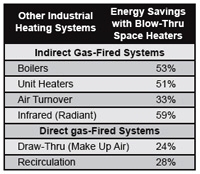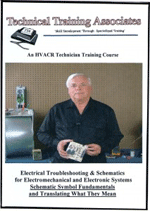
INTRODUCTION
Space heating and lighting consume most of the energy in non-refrigerated warehouses. Installing more efficient lighting to save electrical energy has been well documented by computer modeling. But what about energy modeling guidelines for selecting more efficient gas-fired heating/ventilating equipment that accounts for 75 percent to 95 percent of the gas used at these facilities?This article summarizes the approach, results, and conclusions of a published energy modeling analysis documenting predicted energy performance for six types of gas-fired heating systems commonly used in warehouses and commercial/industrial buildings with large open spaces. The computer simulation analysis includes a comparison to the ASHRAE 90.1 baseline heating system used to determine utility rebates, government tax deductions, energy points for LEED certified buildings, and other incentives for using energy efficient heating equipment. A set of best practices guidelines is provided at the end of the article.
An independent consulting firm performed the energy modeling analysis and wrote a detailed 18-page report summarizing their methods and conclusions. The consulting service has prior experience in energy modeling and doing evaluations of technologies for providing energy efficient heating to buildings. The firm was on the team that helped the U.S. Department of Energy (DOE) develop and test its internationally recognized EnergyPlus energy modeling software, which was used for this analysis. The EnergyPlus software conforms to the modeling requirements of ASHRAE Standard 90.1, it meets the requirements of the U.S. Green Building Council (USGBC) for determining LEED energy credit points, and it is an IRS approved energy modeling software for obtaining Energy Policy Act (EPAct) federal tax deductions.
WAREHOUSE INFORMATION
A 200,000-square-foot generic storage warehouse/distribution center type facility was developed for this study. Building dimensions are 1,000 feet by 200 feet. Long sides of the building are 30-feet high. The roof peak running the long direction is 36-feet high. There are 34 dock doors and the interior of the building is open. The warehouse is constructed and insulated to meet ASHRAE 90.1-2004 guidelines for Columbus, Ohio (climate zone 5). Internal loads include 50 workers, 10 forklift trucks, and lighting based on ASHRAE 90.1. Steel products are assumed to be the type of stored materials. Typical warehouse occupancy, dock door activity, equipment operation, lighting, and infiltration schedules were all simulated on an hourly basis. No office or cold storage areas were included in the analysis in order to focus on just the warehouse heating/ventilating systems.HEATING/VENTILATING SYSTEMS
Seven different natural gas-fired heating/ventilating systems were sized and modeled. The first complies with the specifications in Appendix G of ASHRAE Standard 90.1-2004. The other six are common types of heating equipment used for warehouses and commercial/industrial buildings with large open spaces. Equipment sizing was done by the EnergyPlus program.Equipment Efficiency and Operating Characteristics
1.ASHRAE 90.1 baseline – Indirect fired boiler supplying water reheat for VAV system.
• Output - 180°F max water temperature
• Boiler - 80 percent efficiency
• Provides required ventilation air
2.Direct fired, high temperature rise blow-thru heating system.
• Output - 160°F max temperature rise
• Burner - 92 percent efficiency, variable capacity, modulating control
• Provides required ventilation air
3.Direct fired, lower temperature rise draw-thru make-up air heating system.
• Output - 120°F max temperature rise
• Burner - 92 percent efficiency, variable capacity, modulating control
• Provides required ventilation air
4.Direct fired, recirculation heating system.
• Output - 49°F max equivalent temperature rise (required by ANSI Standard Z83.18)
• Burner - 92 percent efficiency, variable capacity, modulating control
• Provides required ventilation air
5.Indirect fired, power vented unit heater system.
• Output - 50°F max temperature rise
• Burner - 80 percent efficiency, single capacity, on/off control
• Indirect fired make-up air heater provides required ventilation air
6.Indirect fired, air turnover (air rotation) heating system.
• Output - 35°F max temperature rise
• Burner - 80 percent efficiency, single capacity, on/off control
• Indirect fired make-up air heater provides required ventilation air
7.Infrared (radiant), high efficiency (condensing tube) heating system.
• Output - auto-sized by EnergyPlus program to meet heating load
• Burner - 92 percent efficiency, single capacity, on/off control
• Direct fired make-up air heater provides required ventilation air

STANDARD CONDITIONS
• Heating: 65°F during occupied hours; 55°F night/weekend/holiday temperature setback• Ventilation: 0.06 cfm/square foot during occupied hours (to meet ASHRAE Standard 62.1-2007)
• Stratification: 4°F
• Air Conditioning: Not included in the analysis
COMPUTER MODELING RESULTS
Notes:
1. Blow-thru heaters used 35 percent less natural gas and 93 percent less fan electricity than the ASHRAE 90.1 baseline heating system.
2. Blow-thru heaters used the least amount of total energy. As shown in the table above, using any other heater type increased total therms required to heat the warehouse by 24 percent to 59 percent.
3. Infrared heaters were auto-sized by EnergyPlus to handle the total heating load. Analysis and load did not incorporate the practice of keeping the room thermostat set 15-20 percent lower in order to save energy.

STRATIFICATION
A potentially important energy issue for warehouse heating is temperature stratification. Warehouses typically have high open ceilings where significant differences in air temperature can occur between floor level and the ceiling due to lack of adequate air movement. High levels of stratification will waste energy. Reduced stratification is a claimed benefit of destratifying ceiling fans and three of the heating systems modeled in this analysis (Blow-Thru, Air Turnover, and Infrared). Energy modeling software, including EnergyPlus, cannot predict the amount of stratification created by each heating system but it can determine the additional energy used for specific levels of stratification. Therefore each heating system was first modeled using just 4°F stratification and then a second set of modeling results were obtained for 10°F stratification to determine the predicted amount of additional energy used for those buildings that do not use a destratifying heating system or fans.COMPUTER MODELING RESULTS

VENTILATION RATE
ASHRAE Standard 62.1 requires a continuous supply of ventilation air at the minimum rate of 0.06 cfm/square foot for warehouse applications during periods of occupancy. This is a prerequisite for all LEED projects and is also required by many local codes. All seven heating systems were modeled to meet this ventilation requirement. A 30 percent higher ventilation rate of 0.078 cfm/square foot will earn an indoor environmental quality credit point for LEED projects. An additional set of modeling results was obtained for this condition to determine its impact on energy use.COMPUTER MODELING RESULTS

Figure 1. Computer Modeling: Predicted energy savings with blow-thru space heater.
CONCLUSIONS
1.Direct gas-fired, high temperature rise blow-thru space heaters used 35 percent to 38 percent less gas (therms) than the ASHRAE 90.1 baseline heating system for all cases included in this computer analysis. Using any other heater type increased the total therms required to heat the facility by at least 24 percent to 59 percent as shown in Figure 1.Blow-thru heaters use the least amount of energy to heat/ventilate large warehouses based on the following advantages of their design:
• Higher 92 percent efficiency vs. 80 percent rating for all indirect gas fired systems.
• More efficient, variable capacity, modulating control burner.
• Better performance from dual 160°F maximum temperature rise/discharge temperature capability providing a high Btu/cfm ratio, which reduces the effective heating load relative to other direct fired heating systems.
• Electrical energy use is reduced by small blower motor, lower static pressure, and ability to provide both space heat and tempered ventilation using the least amount of outside air.
2.Air turnover, draw-thru make-up air and recirculation type heating systems outperformed the ASHRAE 90.1 baseline heating systems by only 13 percent to 22 percent.
3.Power vented unit heaters are a common way to heat warehouses and were found to virtually match the ASHRAE 90.1 baseline heating system for natural gas use.
4.Although infrared (radiant) heating is a good way to heat stationary objects and small facilities with open spaces, these computer simulation results indicate it to be a poor performer for large buildings that require both space heating and mechanical ventilation. Some manufacturers of infrared heaters recommend using their systems with a rated output 80 percent to 85 percent lower than the heat loss calculated by the ASHRAE Handbook or by turning down the room thermostat by an equivalent amount. This analysis did not incorporate either approach.
5.The ASHRAE 90.1 boiler baseline heating system had much higher fan (electrical) energy use due to the significant static pressure associated with using a ducted heating system for a large open area.
6.The combined effects of ceiling stratification and increased ventilation beyond ASHRAE 62.1 requirements can result in a significant 10 percent to 25 percent energy increase.
BEST PRACTICES GUIDELINES
The following guidelines are recommended for the selection of energy efficient space heating equipment used in warehouses and commercial/industrial buildings with large open spaces.•90+% Efficient Heaters- Select space heaters with energy efficiency ratings above 90 percent to get every possible Btu out of the fuel as usable heat.
•Consider Ventilation and IAQ- Be sure the heating system accounts for the facility’s ventilation and indoor air quality requirements. The use of direct gas-fired, non-recirculating heating equipment certified to ANSI Standard Z83.4 is an energy efficient solution.
•Reduce Stratification- Reduce temperature stratification in buildings with high ceilings. Options include: small blow-thru space heaters with their high velocity vertical throw diffusers; large, low velocity constant air turnover heating units that provide two to three building air-volume turnovers per hour; infrared heating; or the use of ceiling fans.
•Be ASHRAE 90.1 Compliant- Heating equipment should, at a minimum, be compliant with ASHRAE Standard 90.1. As shown by this energy modeling report, this does not necessarily assure you are getting the most energy efficient heating equipment. But it is a requirement for many government tax incentives and utility rebate programs. It is also a prerequisite for LEED buildings. The heater manufacturer should have this stamped on their nameplate.
•Document Energy Savings- Since actual energy savings are the real goal, use a proven technology from an experienced manufacturer that can document energy savings with studies of existing buildings and energy modeling.
Adapted and reprinted with permission from the Cambridge Engineering Inc. white paper “Energy Modeling Warehouse Heating Systems.” For more information, visit www.cambridge-eng.com.
Publication date:07/06/2009








